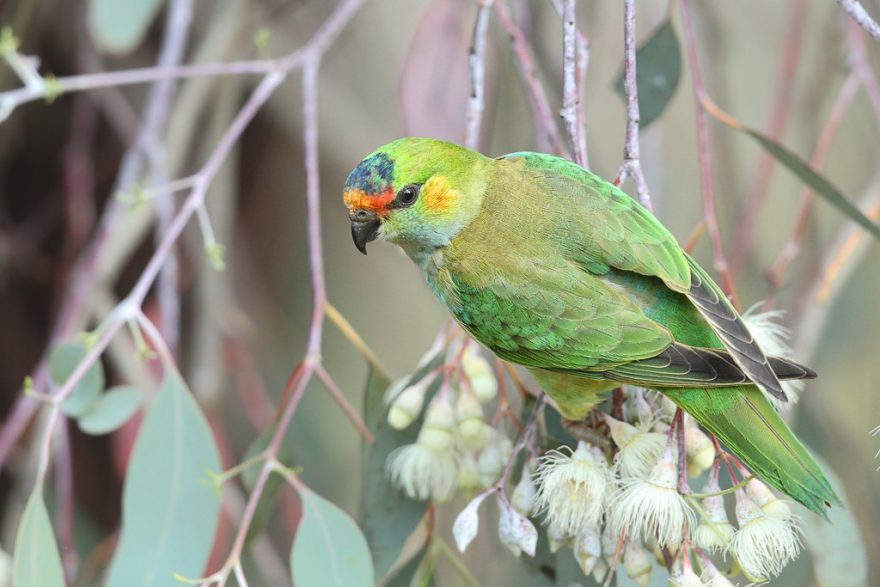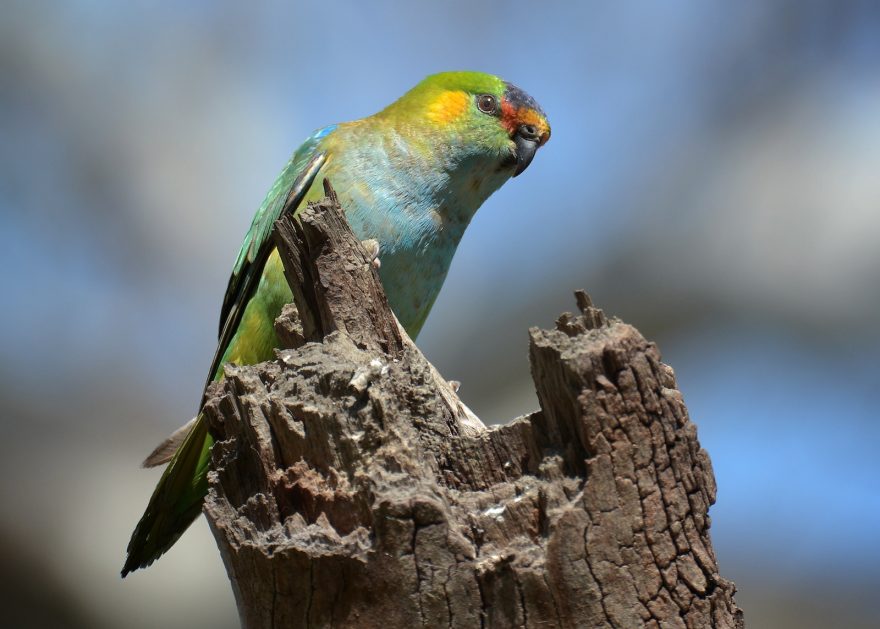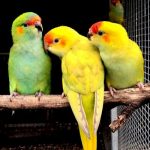The Purple-crowned lorikeet is a small lorikeet native to the southern parts of Australia. They are rarely found in captivity outside of Australia. Even within Australian aviculture, the species is uncommon and has a reputation for being challenging to keep for all but the most experienced lorikeet breeders. Despite their scarcity, the low demand for this species ensures their affordability. A breeding pair can be purchased for approximately $200 Australian dollars.

Housing & Compatibility
Due to their high-moisture diet, Lorikeets produce a large amount of liquid faeces. Many breeders use suspended flights; which allow droppings to fall through the bottom. This reduces exposure to dangerous bacteria and parasites. Frequent cleaning is necessary and the aviary should be designed to accommodate this.
A substrate of sand or gravel that can easily be replaced or pressure-cleaned is needed in traditional style aviaries.
The Purple-crowned lorikeet should not be kept in a small cage or cabinet. A large, planted aviary is an ideal environment for keeping this species. A sufficiently large aviary can be shared by other small non-aggressive parrots, finches, softbills and doves.
Multiple pairs of Purple-crowned lorikeets may be housed together in a sufficiently sized aviary, During the breeding season, it may be necessary to provide multiple feeding stations to reduce aggressive behavior.
Diet
Lorikeets possess a brush tipped tongue which is used to extract nectar and pollen from flowering trees. In captivity; a commercial lorikeet mix and a variety of fruit and vegetables is acceptable. Apple, pear, grapes, tomato and strawberries are particularly enjoyed.
Commercial lorikeet mixes can often be fed dry (in powder form) or wet (mixed with water). Dry food and fresh water should be available at all times, as wet lorikeet food spoils quickly and needs to be replaced several times a day – especially in hot weather.
Lorikeets should not be permitted to consume seed, as it can damage the brush tip on their tongue and contribute to a variety of health issues; many of which lead to a reduced lifespan.

Breeding
Purple-crowned lorikeets will breed from late autumn until the final weeks of spring, however breeding at other times of the year is occasionally observed. They typically produce one clutch of two to four young per season. Some pairs may produce multiple clutches per year.
Breeding usually commences at 12-18 months of age and will continue for most of the Purple-crowned lorikeet’s 7-9 year lifespan. Eggs are incubated for approximately three weeks. Young birds will fledge the nest six to eight weeks after hatching and be fully independent from their parents a few weeks after that.
They will readily accept a wide variety of hollow logs as nesting receptacles. Commercial Lovebird-style nesting boxes can also be used. The nest box should have a shallow bed of rotting wood, sawdust or pine shavings to provide cushioning. The large amount of liquid faeces produced by young birds will quickly soil the nest box, so it needs to be thoroughly cleaned between clutches. Some breeders drill small holes into the bottom of the nest box to allow moisture to escape.
Sexing
DNA sexing is the only way to reliably sex Purple-crowned lorikeets.
The male Purple-crowned lorikeet has a subtle red patch under its wings, visible only when the bird is in flight. The female tends be slightly less vividly coloured.
Mutations

As Pets
The Purple-crowned lorikeet’s docile and confiding nature make them especially good pets. They can tamed with unusual ease by taking advantage of their love of sweet foods. Hand feeding berries or small pieces of fruit will allow you to gain their trust in a relatively short period of time.
Purple-crowned lorikeets do show occasional aggression towards humans. This is especially relevant to female birds. Their small size and nectar-suited beak make this aggression non-threatening and easy to correct.
These birds are not known to talk.
Health
Due to their high-moisture diet, lorikeets produce a large amount of liquid faeces. If aviary hygiene is not adequately maintained, bacterial and fungal infections can thrive. In traditional aviaries, keeping the substrate as dry as possible is essential. Ensure there is good drainage and a substrate—ideally sand—that can be frequently replaced.
Similarly, it’s also important that a lorikeet’s food supply is not permitted to spoil. Fruits, vegetables, and “wet” lorikeet food should be removed on the same day as it’s placed in the aviary. In hot weather, food will spoil more quickly so it may be necessary to provide multiple feedings throughout the day.
A preventative worming and parasite control regime should be applied to ensure the long-term health of your birds.
A healthy purple-crowned lorikeet should have an expected lifespan of 7-9 years. They are quite short-lived compared to other lorikeet species.
Purple crowned lorrikeets favorite fruit is pear followed by pink lady apples (yes they hav a champaine diet) they like a tiny bit of manderine (only very little for a change) they also love spinach leaves and/or silverbeet. They love cooked sweet potato and pumkin too! Spinach/silverbeet gives them calcium. They love cucumber (seeds for some reason) watermelon, rockmelon and natural eucalypt flowers and natural honey! I have a saved purple crowned lorrikeet! She has a head injury and it causes her not to be able to fly! She is well looked after and she is a beautiful part of our family! We always harvest flowers for her in season from eucalypt trees. She has dried specialised lorrikeet powder all the time available to her plus lots of fresh water (3 times a day)
Jus to continue on with experiencing a saved purple crowned lorrikeet! They make the most devoted pet! I saved my little girl! I found her on the side of the road! She was all huddled up and i happened to spot her driving home (i dont normally drive to work but, i did happen to that day it was 21/5/2016) i saw her! Huddled in a lilttle green blob on a corner! I stopped and picked her up! I brought her home! Put her into a cage wrapped with warm covers!! I didnt know if she would live overnight) she did!!! Then i had to work out what she was! I tried feeding her with a syringe cas i knew she was jus out of the nest! This tongue kept coming out! I hav hand reared lots of bird babies but i was WAT! rang our local wildlife person! Mmm a lorrikeet! Got powder food! Happy pants! She must hav got concussion! She lapped up the wet lorrikeet food when she came too! She was not long out of the nest! She had no colouring! I brought her home and it was a number of months until she got her purple crown! She still has head injury traits! She really cant fly and sometimes when she accidentally takes off (not very often) she doesnt know where she is going and spirals! Pip is now 5 years old and we continue to keep her safe and we do the upmost to feed and look after her well. Most of all we love her!!